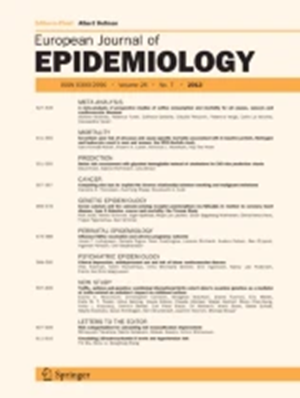绝经后早期乳腺癌芳香化酶抑制剂治疗后ldl -胆固醇水平的变化
IF 5.9
1区 医学
Q1 PUBLIC, ENVIRONMENTAL & OCCUPATIONAL HEALTH
引用次数: 0
摘要
芳香化酶抑制剂(AIT)治疗可能会对血脂水平产生不利影响,这是一个悬而未决的问题。鉴于患有乳腺癌的妇女生存率提高,老年人患动脉粥样硬化性心血管疾病的风险增加,对血脂水平的不利影响可能是这组患者的一个重大健康问题。我们使用了来自全国登记的相关数据,包括一个包含分配和分配AIT信息的临床乳腺癌数据库。在此基础上,我们调查了2009-2020年丹麦全国绝经后早期乳腺癌妇女AIT后血浆脂质水平的变化(主要结局:低密度脂蛋白-胆固醇,次要结局:高密度脂蛋白-胆固醇,总胆固醇和甘油三酯)。这些女性在乳腺癌诊断前后至少进行了一次低密度脂蛋白胆固醇检测。与未分配和未分配AIT相比,暴露于分配和分配AIT。结果是根据AIT调整后的血脂水平变化差异(从乳腺癌诊断前后)。在10,461名妇女中,有22,693名乳腺癌前低密度脂蛋白胆固醇测量和42,750名乳腺癌后低密度脂蛋白胆固醇测量。总的来说,7919名妇女暴露于AIT, 2542名妇女没有暴露。AIT暴露组ldl -胆固醇变化为- 0.16 mmol/L (mM),未暴露组为- 0.15 mM。AIT暴露组与未暴露组ldl -胆固醇变化的相应调整差异为- 0.03 mM (95% CI - 0.07 ~ 0.003)。我们在分析次要结果时发现了类似的结果。这项研究不支持AIT对血脂水平不利的担忧。本文章由计算机程序翻译,如有差异,请以英文原文为准。
Changes in LDL-cholesterol levels following aromatase inhibitor treatment in early postmenopausal breast cancer.
There is an unsettled concern that treatment with aromatase inhibitors (AIT) may adversely affect lipid-levels. In light of the improved survival of women with breast cancer and increased risk of atherosclerotic cardiovascular disease in older people, unfavorable effects on lipid-levels may represent a significant health concern for this group of patients. We used linked data from nationwide registries, including a clinical breast cancer database with information about allocated and dispensed AIT. Based on these, we investigated changes in plasma lipid-levels (primary outcome: low-density lipoprotein (LDL)-cholesterol, secondary outcomes: high-density lipoprotein (HDL)-cholesterol, total cholesterol, and triglycerides) following AIT in a nationwide cohort of postmenopausal women with early breast cancer, Denmark, 2009-2020. Included women had at least one LDL-cholesterol measurement before and after breast cancer diagnosis. Exposure was allocated and dispensed AIT as compared with not allocated to and no dispensed AIT. Outcome was the adjusted difference in lipid-level-change (from before to after breast cancer diagnosis) according to AIT. Among 10,461 women, there were 22,693 pre-breast cancer LDL-cholesterol measurements and 42,750 post-breast cancer LDL-cholesterol measurements. Overall, 7919 of the women were exposed to AIT and 2542 women were unexposed. For AIT exposed, the LDL-cholesterol-change was - 0.16 mmol/L (mM), and for unexposed, - 0.15 mM, respectively. The corresponding adjusted difference in LDL-cholesterol change for AIT exposed versus unexposed was - 0.03 mM (95% CI - 0.07 to 0.003). We found similar results in analysis of secondary outcomes. This study does not support the concern that AIT adversely affects lipid-levels.
求助全文
通过发布文献求助,成功后即可免费获取论文全文。
去求助
来源期刊

European Journal of Epidemiology
医学-公共卫生、环境卫生与职业卫生
CiteScore
21.40
自引率
1.50%
发文量
109
审稿时长
6-12 weeks
期刊介绍:
The European Journal of Epidemiology, established in 1985, is a peer-reviewed publication that provides a platform for discussions on epidemiology in its broadest sense. It covers various aspects of epidemiologic research and statistical methods. The journal facilitates communication between researchers, educators, and practitioners in epidemiology, including those in clinical and community medicine. Contributions from diverse fields such as public health, preventive medicine, clinical medicine, health economics, and computational biology and data science, in relation to health and disease, are encouraged. While accepting submissions from all over the world, the journal particularly emphasizes European topics relevant to epidemiology. The published articles consist of empirical research findings, developments in methodology, and opinion pieces.
 求助内容:
求助内容: 应助结果提醒方式:
应助结果提醒方式:


